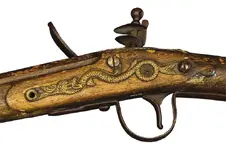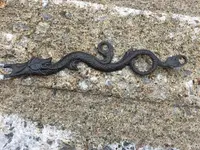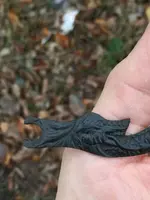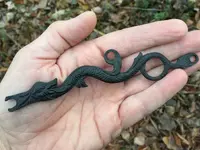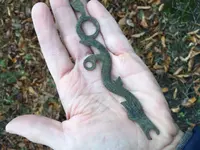Relicific
Silver Member
Closed out my 2017 hunts last week and man did I feel luckier than a lucky penny
when I pulled this intact British trade musket serpent sideplate out of the ground.
I've seen other examples posted online,but they were mostly broken off pieces.
Intact side plates are very rare cause first off these british muskets were notorious
for exploding barrels and so the sideplate would be destroyed in the process.
Also some Native tribes would "ritualistically" kill the serpent by breaking it into pieces
and burying it.
Beginning in 1690 English gun makers used decorative sideplates in place of loops
and scrolls and by the mid 1700's serpent sideplates were standard on British trade guns.
These serpent/dragon sideplates became a very important symbol of the fur trade.
For the Native,it came to mean they were getting the genuine article when they traded
the twenty or so beaver pelts it took to get a trade gun.
The snake was also spiritually significant for hunters and ensured fruitful hunting.
Indians had come to expect the trade gun had this serpent on it.
No snake,no deal.
Traders then obviously insisted upon it too.
Trade guns sporting these sideplates were also know as Northwest or Mackinaw guns.
I've added a before and after cleaning photos.
when I pulled this intact British trade musket serpent sideplate out of the ground.
I've seen other examples posted online,but they were mostly broken off pieces.
Intact side plates are very rare cause first off these british muskets were notorious
for exploding barrels and so the sideplate would be destroyed in the process.
Also some Native tribes would "ritualistically" kill the serpent by breaking it into pieces
and burying it.
Beginning in 1690 English gun makers used decorative sideplates in place of loops
and scrolls and by the mid 1700's serpent sideplates were standard on British trade guns.
These serpent/dragon sideplates became a very important symbol of the fur trade.
For the Native,it came to mean they were getting the genuine article when they traded
the twenty or so beaver pelts it took to get a trade gun.
The snake was also spiritually significant for hunters and ensured fruitful hunting.
Indians had come to expect the trade gun had this serpent on it.
No snake,no deal.
Traders then obviously insisted upon it too.
Trade guns sporting these sideplates were also know as Northwest or Mackinaw guns.
I've added a before and after cleaning photos.
Amazon Forum Fav 👍
Attachments
Last edited:
Upvote
99



